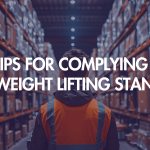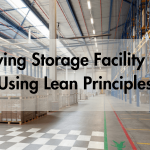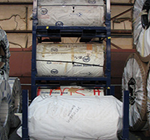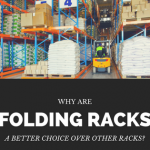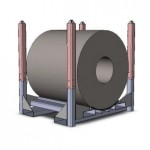Carton Flow Racks vs. Static Racking: Which Is Better for You?
Efficient warehouse management is crucial to the success of any business that relies on effective storage solutions. One of the critical decisions that many companies face is choosing between carton flow racks and static racking systems. Each system has unique features, advantages, and potential downsides depending on the specific needs of your operations.
In this blog, we will compare carton flow racks and static racking, highlighting their key differences, benefits, and challenges.
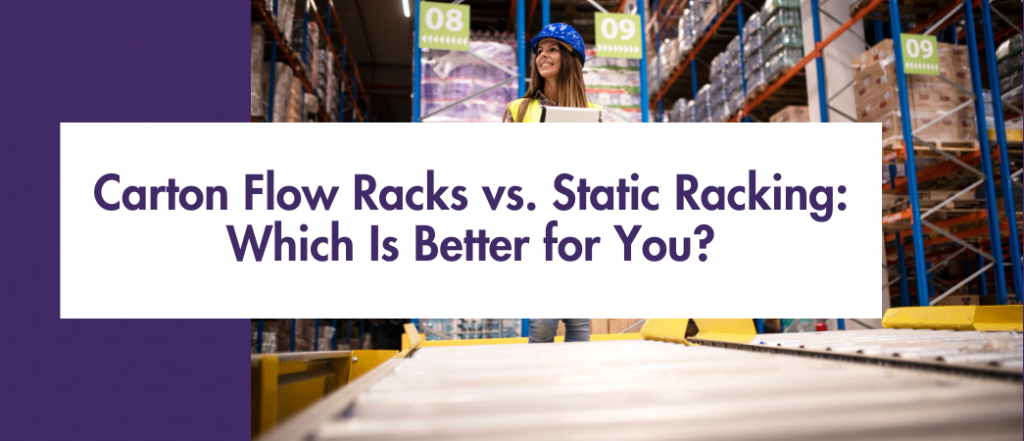
What Are Carton Flow Racks?
Carton flow racks (also known as carton flow rack systems) are dynamic storage systems that use a gravity-fed mechanism. These racks are designed with angled roller tracks or wheels that allow cartons, bins, or products to “flow” from the loading end to the picking end. Workers load products on one side, and they slide forward to the front for easy picking on the opposite side.
The system works on a first-in, first-out (FIFO) basis, making it ideal for products with expiration dates or items that need regular stock rotation. Because the items automatically move forward, the need for constant product shuffling is eliminated, resulting in significant labor savings.
What Is Static Racking?
Static racking, as the name implies, is a storage system where items remain in fixed positions. It is a more traditional warehouse solution, consisting of rows of shelves where goods are manually placed and retrieved. This system requires workers to handle the picking and replenishment of products, often leading to additional time spent searching for items or re-organizing stock.
While static racking doesn’t offer the automatic stock rotation of a carton flow rack system, it is widely used due to its simplicity, versatility, and lower upfront costs. Static racks can be easily customized to different shelf heights and widths, accommodating a wide range of products.
Key Features of Carton Flow Racks
- Dynamic Storage: Products automatically move forward using a gravity-fed system.
- First-In, First-Out (FIFO): This design ensures that older stock is picked first, minimizing waste due to expiration.
- Efficient Picking: The system improves order picking speed because products are always within easy reach.
- Reduced Labor Costs: Since items are automatically presented to the picker, less time is spent moving around and searching for stock.
- Better Space Utilization: By optimizing space and reducing aisle widths, carton flow racks allow for more storage in smaller areas.
Key Features of Static Racking
- Fixed Shelving: Products stay in place, with no movement unless manually shifted.
- More Control Over Stock: Workers have full control over what items are placed on which shelves.
- Customization Options: Static racking systems can be easily adjusted in height, depth, and shelf count, depending on the type and size of the products.
- Lower Initial Costs: Generally, static racks are less expensive to install compared to more complex systems like carton flow racks.
- Ideal for Low Turnover Inventory: Static racking works well for items that don’t need frequent stock rotation or fast-paced picking.
Pros and Cons of Carton Flow Racks
Pros:
- Improved Efficiency: Carton flow racks significantly improve order fulfillment speed, reducing the time spent on picking, replenishing, and moving stock.
- FIFO Stock Rotation: For industries like food, pharmaceuticals, or retail, FIFO is essential for reducing expired stock, and carton flow racks naturally support this system.
- Labor Savings: Fewer man-hours are required to manage inventory because the system automatically brings stock to the front, which reduces picker travel times.
- Better Space Utilization: These racks help maximize available space, especially in warehouses with high SKU counts or limited floor space.
Cons:
- Higher Initial Cost: The upfront investment for a carton flow rack system is usually higher than for static racking due to the complexity of the design and installation.
- Maintenance: While not labor-intensive, carton racks require periodic checks to ensure the flow mechanism is functioning correctly. Broken wheels or tracks may cause jams and slow down operations.
- Not Ideal for All Products: Carton flow racks are not suitable for products that are irregularly shaped or extremely heavy, which might hinder the smooth flow down the gravity tracks.
Pros and Cons of Static Racking
Pros:
- Lower Cost: Compared to carton flow systems, static racking is a more affordable storage solution, especially for businesses with tight budgets.
- Versatility: Static racking systems can be configured for various warehouse layouts and product types. You can adjust the shelving height or width to accommodate different-sized items.
- Simplicity: Static racking doesn’t require complex mechanisms, so maintenance is minimal, and operational processes remain simple.
- Good for Slow-Moving Inventory: For warehouses that store low-turnover products, static racking is often sufficient without the need for dynamic flow systems.
Cons:
- Slower Picking: Workers need to spend more time locating, retrieving, and replenishing products. This leads to more walking and longer order fulfillment times.
- Lack of FIFO Rotation: Without built-in stock rotation, it’s harder to ensure that older products are picked first. This can lead to expired stock or older items remaining unsold for extended periods.
- Poor Space Utilization: While static racks are customizable, they don’t make the best use of vertical or horizontal space compared to dynamic systems like carton flow racks.
Comparing Carton Flow Racks and Static Racking
Now that we’ve explored the key features, pros, and cons of carton flow racks and static racking, let’s directly compare the two systems across several essential factors.
1. Picking Efficiency
If speed is your priority, carton flow racks are the superior choice. Since products automatically move to the front, pickers don’t need to spend as much time searching for or walking between products. In contrast, static racking systems require more manual intervention and result in slower picking times.
2. Stock Rotation
For businesses with perishable goods or products that require regular stock rotation, carton flow racks are the better option due to their FIFO design. In static racking, stock rotation is entirely dependent on workers manually rotating the stock, which increases the risk of human error.
3. Space Utilization
In terms of maximizing warehouse space, carton racks can store more items in a smaller footprint compared to static racking. The design of carton flow racks optimizes space usage by reducing the need for wide aisles and allowing for deeper shelves that still maintain ease of access.
4. Cost Considerations
If upfront cost is the deciding factor, static racking will generally be more affordable. It is simpler to install and requires no additional moving parts. However, carton flow rack systems provide longer-term savings in terms of labor efficiency and space optimization.
5. Product Compatibility
While carton flow racks work well for standard-sized boxes and cartons, static racking is more versatile when it comes to accommodating products of varying shapes, sizes, and weights. For businesses that store a wide range of product types, static racking may be a more suitable option.
6. Labor Costs
The automatic product presentation in carton flow racks leads to a reduction in labor costs because pickers spend less time walking and handling stock. Conversely, static racking requires more manual effort, potentially increasing labor expenses over time.
Which System is Best for You?
The decision between carton flow racks and static racking depends on your warehouse’s specific needs. Below are some scenarios to help you decide which system may be better for your business.
Choose Carton Flow Racks If:
- You have fast-moving products and require quick picking speeds.
- FIFO inventory management is crucial to your operations, such as in the food, pharmaceutical, or retail industries.
- You need to maximize space in a small or densely packed warehouse.
- Labor savings are a priority, and you’re looking for ways to reduce worker travel time.
Choose Static Racking If:
- Your products have slow turnover rates, and speed is not the main priority.
- You need a versatile, low-cost storage solution that can handle a wide range of product shapes, sizes, and weights.
- Stock rotation and FIFO management are not significant concerns for your inventory.
- You have a large warehouse with ample space for more traditional storage solutions.
Can You Combine Carton Flow Racks and Static Racking?
In many cases, businesses benefit from a hybrid approach, using both carton flow racks and static racking in different parts of the warehouse. For example, fast-moving, perishable goods can be stored in carton flow racks near the picking area, while bulkier, slow-moving items can be stored in static racking further away.
This combination allows companies to optimize their operations, balancing efficiency, cost, and flexibility. Many businesses find that investing in carton flow rack systems for their high-demand products and maintaining static racking for less critical items offers the best of both worlds.
Conclusion
Both carton flow racks and static racking have their advantages, depending on your warehouse’s specific operational needs. Carton flow racks are excellent for businesses focused on speed, stock rotation, and space efficiency, while static racking works well for companies that require flexibility, cost-effectiveness, and simplicity. Understanding the strengths and weaknesses of both systems is essential to making an informed decision. By analyzing your inventory turnover, space requirements, and labor costs, you can determine whether a carton flow rack system, static racking, or a hybrid solution will work best for your business.
About The Author




